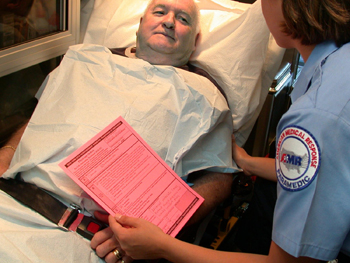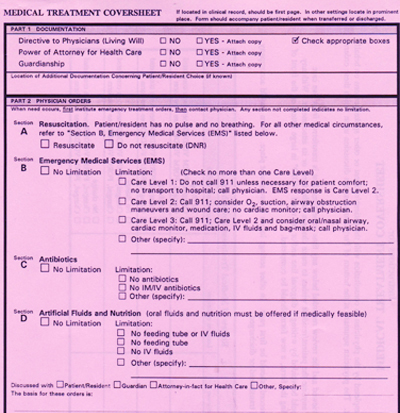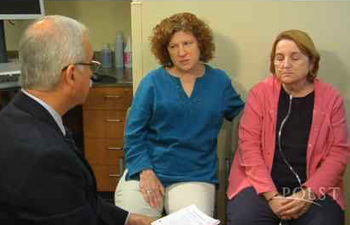Obamacares pink-slip (POLST) Emergency Response...
by Elizabeth D. Wickham, Ph.D.
I invite you to read this sermon (here & here) by Cardinal Clemens August von Galen delivered 71 years ago. He spoke courageously to Germans who, at that time, were witnessing State-sanctioned mercy killings, explaining clearly their obligations of conscience.
A more subtle type of State-sanctioned mercy killing is rapidly advancing across the USA called the POLST (Physician’s Orders for Life Sustaining Treatment) paradigm. POLST is known by different acronyms in various States (POLST, MOST, MOLST, POST --- some States even have their unique designation such as CA POLST, MN POLST). Perhaps the mix of names is one of the reasons most people have not yet become aware of this developing tool of the “third path” euthanasia movement.
Third path of the euthanasia movement
POLST is changing the definition of what qualifies as physician’s orders. The result is that good moral physicians are being forced by law to act against their consciences and permit their patients to die because they must follow the orders given by others on these POLST forms.

POLST facilitators pressure the elderly |
POLST acts as a DNR (Do Not Resuscitate) because in substance it is a DNR with bells and whistles. POLST is sometimes referred to by the euthanasia movement as an out-of-hospital DNR. It is a bright colored piece of paper (usually pink) which travels with the patient into every healthcare setting. Usually it ends up on the refrigerator or other place of prominence in the home so Emergency Medical Services (EMS) can quickly find the form before beginning any medical procedures.
POLST was developed by the “third path” wing of the euthanasia movement that presents itself as the moral alternative to physician assisted suicide. The original POLST task force began their work in the late 1980s early 1990s in the State of Oregon a few years before Oregon passed the Death with Dignity Act. The first official POLST form was incorporated into Oregon’s healthcare system in 1995. Many of the POLST framers were associated with the Oregon Health Science University (OHSU), which has also been a leader in the development of palliative medicine.
Public debate over physician assisted suicide has drawn America’s attention away from the activities of this less visible wing of the euthanasia movement. It has used palliative medicine as its vehicle and established palliative medicine as the standard for end-of-life care, evidenced by the fact that the POLST paradigm is sailing through State legislatures -- unopposed.
In the first half of 2010 Colorado and Louisiana adopted versions of POLST statewide, joining 12 other States authorizing the POLST paradigm (CA, HI, ID, MD, NY, NC, OR, TN, UT, VT, WA, WV). See “Summary of Health Care Decision Statutes Enacted in 2010” by Mills and Sabatino here.
Signing the death form
The idea behind POLST is simple – complement the living will document by designing a cookie cutter, one-size-fits all form that would have the power of physician’s orders but would not require the bulkiness of execution represented by notarization and witnesses. To fill out the forms the patients simply check certain boxes which indicate specific treatment they do or do not wish.

A patient is asked to sign the pink form as he is wheeled into an ambulance |
Early on, the visual advanced by those promoting the POLST form was a patient on a gurney being wheeled into an ambulance while at the same time being offered the POLST form for his signature. That picture itself should have sent warning signals to those who saw it.
What is deemed appropriate for the use of POLST has expanded since then. POLST is replacing the Do Not Resuscitate form as the form of record in nursing homes. POLST, today advertised as the tool to guarantee patient-centered care, is becoming thoroughly integrated into the operations of palliative care teams. POLST is marketed as a tool to reassess and re-document a patient’s goals as his condition changes.
Scheduled for a quiet return
When the first versions of the healthcare bill were made public, it became obvious that the “third path” euthanasia movement intended to incorporate the POLST form into the health care reform act. Section 1233 of the House version contained the POLST form as a backdrop for end-of-life discussions. It was billed as an agreement between the physician and patient, but in reality it is between the patient and a POLST ‘facilitator,’ who might very well not be a physician or nurse. In that proposed federal bill, the form was called OLST (Orders for Life Sustaining Treatment).
Sarah Palin quickly called attention to Section 1233, calling it “death panels.” The euthanasia promoters were quite upset and quickly went into a damage control mode. They denied being “death panels,” even suggesting the term “life panels” was more appropriate. In the end, however, OLST was removed from the final version of the bill before its passage because of the uproar.

A sample draft of one of the pink POLST form |
Nonetheless, federally-funded OLST end-of-life consulting sessions were scheduled for a quiet return by fiat through changes in the federal rules and regulations to make them part of the annual medicare wellness visits. Scheduled for implementation in early January, 2011, the proposed new CNS regulations were dropped very suddenly after Robert Pear of the NY Times revealed their clandestine tactics in a front page story published on Christmas Day, 2010. Apparently, they have reverted back to their strategy of introducing the POLST paradigm State-by-State.
Much of the information about POLST is misleading. Advocates of POLST claim that the patient and the physician together fill out the POLST form. In reality the physician usually has a minimal part in the discussion if any at all. Instead, specially trained POLST facilitators, who are generally social workers, chaplains, hospital administrators, etc., help with the form filling and then present it to the doctor for his signature.
The Affordable Care Act of 2010 authorizes large government subsidies for training people who will “aid in decision making.” In other words, many more POLST facilitators will be trained with federal monies using, for example, the Respecting Choices curriculum developed in LaCrosse, WI.
Working from training modules which include suggested POLST conversations and scripts, the goal is to steer patients into checking boxes which would limit medical treatment. (Of course these limitations will save considerable costs in our time of economic hardship.) Will the POLST form be filled out with proper informed consent? Doubtful.
Efforts have now turned to making sure that all POLST forms are recorded electronically and updated regularly. Health care professionals with their hand held computers will have access to the POLST form during rounds, but everyone will be legally bound by the checked boxes.
No turning back
Will it be possible for families, who realize that Grandma and her facilitator made some foolish choices that are now part of her electronic health records, to rescind those orders and reclaim the full range of options for Grandma’s medical care? The promoters of POLST would deny that option.

No opportunity for family members to change the form, once signed |
In July 2012 the Wisconsin Catholic Bishops released a pastoral statement warning against the POLST form. They emphasize in their statement that there will be conflicts of conscience presented to healthcare professionals and institutions. They state very clearly:
“Due to the serious and real threats to the dignity of human life that POLST and all similar documents present, we encourage all Catholics to avoid using all such documents, programs, and materials. The POLST form should not be regarded as the standard model for designating treatment preferences.” Read more here.
Just as Bishop von Galen spoke out in Germany some 70 years ago, we now have the first statement about POLST conscience problems signed by all five of the bishops in the state of Wisconsin.
We pray for guidance from the Holy Spirit to help us understand that general acceptance of the POLST paradigm brings about a Pandora’s Box of conscience problems.
Dr. Elizabeth D. Wickham is Executive Director of LifeTree, an educational nonprofit organization that protects life from its earliest beginnings to natural death. She can be contacted at PO Box 17301 - Raleigh, NC, 27619 - Phone: 919-785-0855
